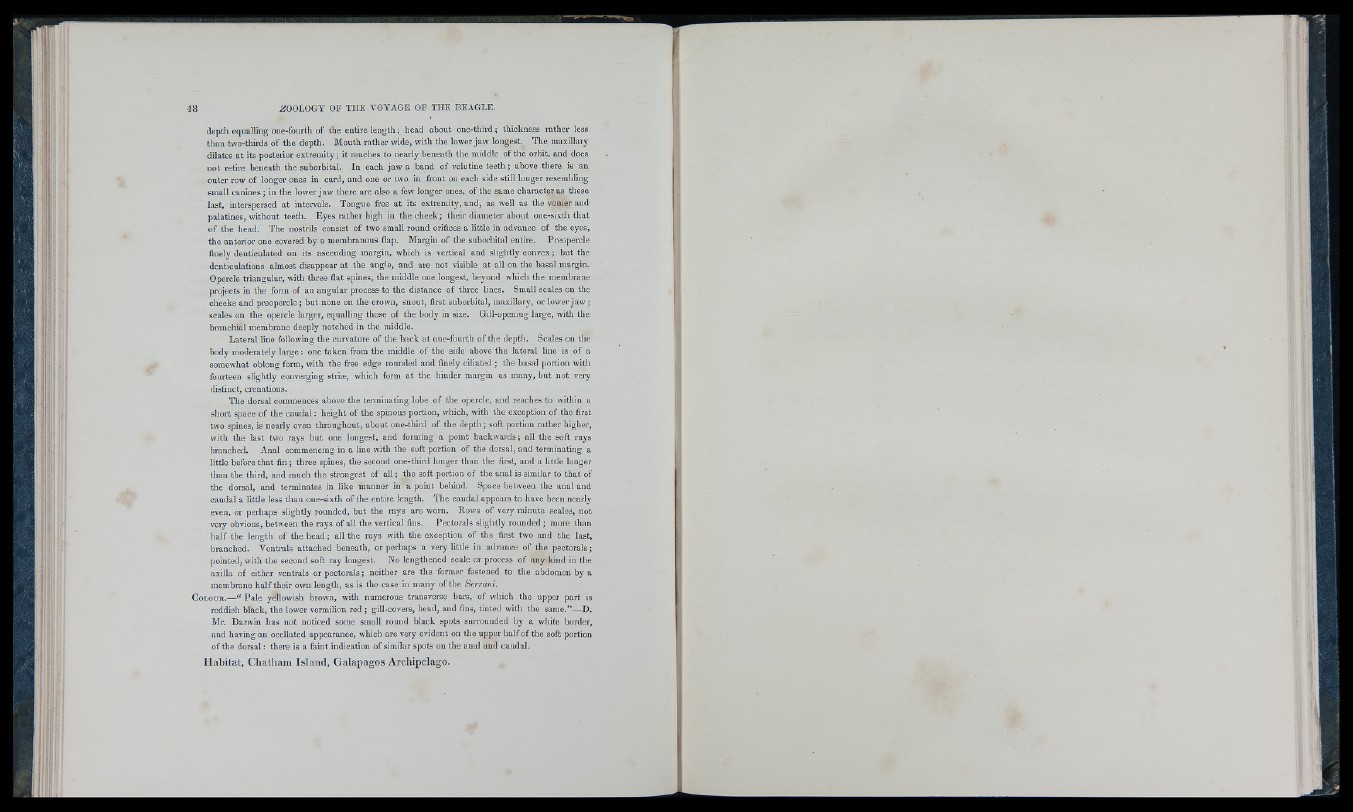
depth equalling one-fourth of the entire length ; head about one-third ; thickness rather less
than two-thirds of the depth. M outh rather wide, with the lower jaw longest. The maxillary
dilates a t its posterior extremity ; it reaches to nearly beneath the middle of the orbit, and does
not retire beneath the suborbital. In each jaw a band of velutine teeth ; above there is an
outer row of longer ones in card, and one or two in front on each side still longer resembling-
small canines ; in the lower jaw there are also a few longer ones, of the same character as these
last, interspersed at Intervals. Tongue free at its extremity, and, as well as the vomer and
palatines, without teeth. Eyes rather high in the cheek; their diameter about one-sixth that
of the head. The nostrils consist of two small round orifices a little in advance of the eyes,
the anterior one covered by a membranous flap. M argin of the suborbital entire. Preopercle
finely denticulated on its ascending margin, which is vertical and slightly convex ; but the
denticulations almost disappear at the angle, and are not visible a t all on the b-asal margin.
Opercle triangular, with three flat spines, the middle one longest, beyond which the membrane
projects in the form of an angular process to the distance of three lines. Small scales on the
cheeks and preopei-cle ; but none on the crown, snout, first suborbital, maxillary, or lower jaw ;
scales on the opercle larger, equalling those of the body in size. Gill-opening large, with the
branchial membrane deeply notched in the middle.
Lateral line following the curvature of the back a t one-fourth of the depth. Scales on the
body moderately large : one taken from the middle of the side above the lateral line is of a
somewhat oblong form, with the free edge rounded and finely ciliated ; the basal portion with
fourteen slightly converging striæ, which form at the hinder m argin as many, but not very
distinct, crenations.
The dorsal commences above the terminating lobe of the opercle, and reaches to within a
short space of the caudal : height of the spinous portion, which, with the exception of the first
two spines, is nearly even throughout, about one-third of the depth ; soft portion rather higher,
with the last two rays but one longest, and forming a point backw ards; all the soft rays
branched. Anal commencing in a line with the soft portion of the dorsal, and terminating a
little before that fin ; three spines, the second one-third longer than the first, and a little longer
than the third, and much the strongest o f all; the soft portion of the anal is similar to that of
the dorsal, and terminates in like manner in a point behind. Space between the anal and
caudal a little less than one-sixth of the entire length. The caudal appears to have been nearly
even, or perhaps slightly rounded, b u t the rays are worn. Rows of very minute scales, not
very obvious, between the rays of all the vertical fins. Pectorals slightly rounded ; more than
half the length of the head ; all the rays with the exception of the first two and the last,
branched. Ventrals attached beneath, or perhaps a very little in advance of the pectorals ;
pointed, with the second soft ray longest. No lengthened scale or process of any kind in the
axilla of either ventrals or pectorals; neither are the former fastened to the abdomen by a
membrane half their own length, as is the case in m any of the Serrani.
C o l o u r .— “ Pale yellowish brown, with numerous transverse bars, of which the upper part is
reddish black, the lower vermilion red ; gill-covers, head, and fins, tinted with the same.”— D.
Mr. Darwin has not noticed some small round black spots surrounded by a white border,
and having an ocellated appearance, which are very evident on the upper half of the soft portion
of the dorsal : there is a faint indication of similar spots on the anal aud caudal.
Habitat, Chatham Island, Galapagos Archipelago.